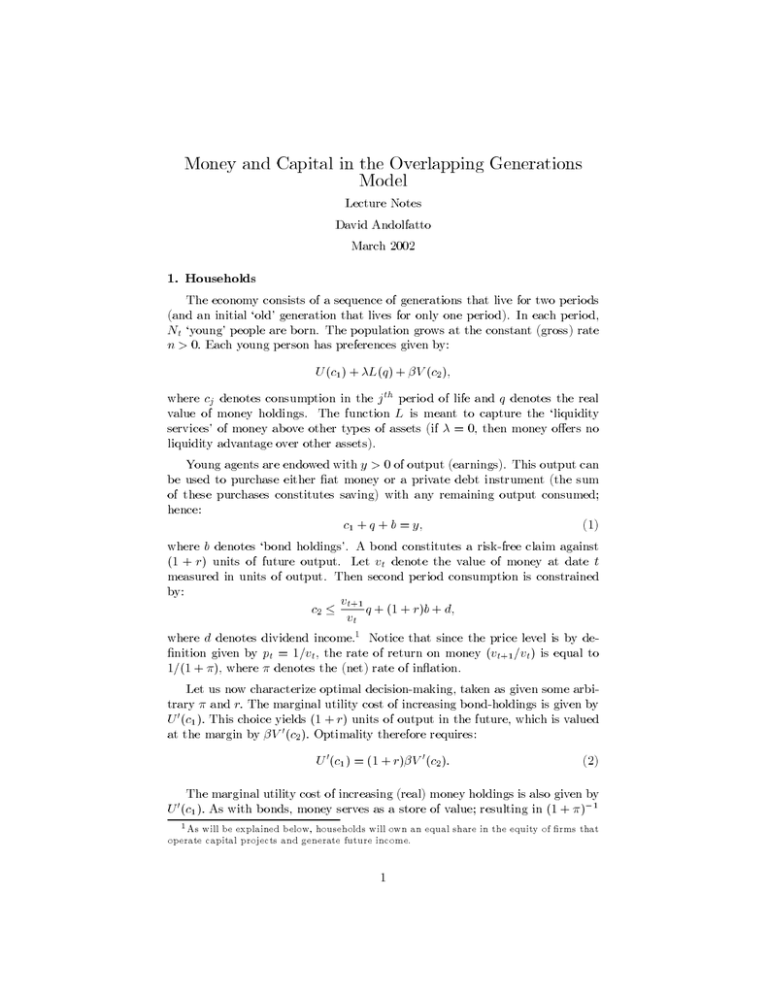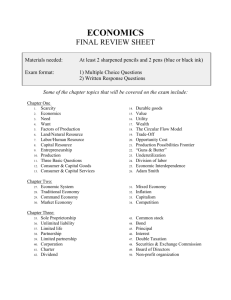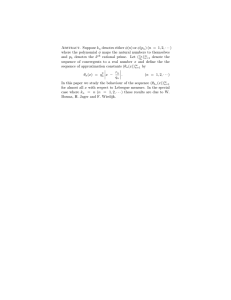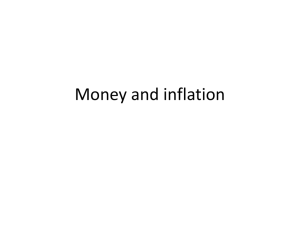Money and Capital in the Overlapping Generations Model
advertisement

Money and Capital in the Overlapping Generations Model Lecture Notes David Andolfatto March 2002 1. Households The economy consists of a sequence of generations that live for two periods (and an initial ‘old’ generation that lives for only one period). In each period, Nt ‘young’ people are born. The population grows at the constant (gross) rate n > 0. Each young person has preferences given by: U (c1 ) + λL(q) + βV (c2 ), where cj denotes consumption in the j th period of life and q denotes the real value of money holdings. The function L is meant to capture the ‘liquidity services’ of money above other types of assets (if λ = 0, then money offers no liquidity advantage over other assets). Young agents are endowed with y > 0 of output (earnings). This output can be used to purchase either fiat money or a private debt instrument (the sum of these purchases constitutes saving) with any remaining output consumed; hence: (1) c1 + q + b = y, where b denotes ‘bond holdings’. A bond constitutes a risk-free claim against (1 + r) units of future output. Let vt denote the value of money at date t measured in units of output. Then second period consumption is constrained by: c2 ≤ vt+1 q + (1 + r)b + d, vt where d denotes dividend income.1 Notice that since the price level is by definition given by pt = 1/vt , the rate of return on money (vt+1 /vt ) is equal to 1/(1 + π ), where π denotes the (net) rate of inflation. Let us now characterize optimal decision-making, taken as given some arbitrary π and r. The marginal utility cost of increasing bond-holdings is given by U (c1 ). This choice yields (1 + r) units of output in the future, which is valued at the margin by βV (c2 ). Optimality therefore requires: U (c1 ) = (1 + r)βV (c2 ). (2) The marginal utility cost of increasing (real) money holdings is also given by U (c1 ). As with bonds, money serves as a store of value; resulting in (1 + π) −1 1 As will be explained below, households will own an equal share in the equity of firms that operate capital projects and generate future income. 1 units of future output, which is valued at the margin by βV (c2 ). In addition to this benefit, the additional real money holdings yield ‘liquidity services’, which are valued at the margin by λL (q). Optimality therefore requires: U (c1 ) = λL (q) + (1 + π) 1 βV (c2 ). − Let us now simplify things a little bit by assuming that the marginal utility of second-period consumption is constant (and equal to β ). We can then combine the two conditions above to derive the following expression (which implicitly defines the individual’s demand for real money balances): (3) λL (qd ) + (1 + π)−1 β = (1 + r)β. From this restriction, we can deduce that qd depends negatively on both r and π. The intuition here is that an increase in the return on an asset that competes as a store of value will cause people to substitute away from lower return assets (in this case, money) into the higher return asset. Likewise, an increase in the rate of inflation is equivalent to a lower pecuniary rate of return on the money asset, causing people to substitute out of money. Notice that as long as money provides liquidity services (λ > 0), it is possible to have money dominated in rate of return and yet still held. Rate of return dominance implies: 1 , 1+π or (1+r)(1+π) > 1. The term (1+r)(1+π) has the interpretation of representing (1 + r) > the nominal rate of interest (i.e., the future return on a bond measured in monetary units). If we define (1 + i) = (1 + r)(1 + π), then rate of return dominance can be restated simply as i > 0. In other words, bonds pay positive nominal interest while money pays zero nominal interest.2 Now, from condition (2) and (1), we have: U (y − sd ) = (1 + r)β, (4) s q b s r. where d = d + d represents desired saving. Notice that d is increasing in it must be the case Since we’ve already established that d is decreasing in that d is increasing in It will be useful to think of d as the ‘supply of loanable funds’ that firms can potentially acquire in order to finance capital expenditure. b r. q b r, 2. Firms There are N firms each of which operates a capital project that transforms k units of current output into F (k) units of future output, where F is increasing t = 0, then savers will only hold the higher return saving instrum ent. If b oth money (1 + )(1+ ) = 1 offer a p ositive real return r > 0, then inflation must be suffi ciently negative (deflation) if 2 If λ and bonds are to b e held, they must therefore earn the sam e real return; and this can only happ en if the nominal rate of interest is equal zero: r π . In particular, if b onds p eople are to also hold m oney. 2 k a strictly concave. Resources for the capital expenditure must be acquired in the corporate debt (bond) market. After settling the claims of bondholders (both interest and principal), the firm distributes a dividend payment at to each of the t old households; i.e., d t +1 N d = max[F (k) − (1 + r)k] k The solution to this choice problem generates an investment demand schedule kd that satisfies: F kd r . ( ) = (1 + ) Clearly, kd depends negatively on r. 3. Government The government controls the supply of money, which is assumed to grow zMt−1 . The initial money stock is at some constant (gross) rate z i.e., Mt distributed equally to the initial old generation. Assume that the government simply consumes seigniorage revenue and that such expenditure does not directly affect the marginal utility of private consumption (consequently, we can ignore government spending, unless we want to talk about welfare). = ; 4. Equilibrium We now impose the market clearing restrictions for money and bonds. In kd k∗ which implies that: the bond market, bd = = , r ) = F (k ). In the money market, v M = N q for all t, which implies that: n 1 = . (1 + π ) z (1 + t t t ∗ ∗ d ∗ − Combining these latter two relations with (3), we have the following restriction: λL (q ) = β[F (k ) − nz ]. ∗ ∗ (5) In addition, from (4) and making the obvious substitutions, we can write: U (y − q ∗ −k ∗ ) = βF (k∗ ). (6) The two equations (5) and (6) characterize the equilibrium quantities (q∗ , k∗ ). Notice that if λ = 0, then the equilibrium capital stock adjusts to a point at which the real return on capital investment just equals the real return on money. 5. An Expansionary Monetary Policy: The Tobin Effect What are the economic consequences of a more rapidly expanding supply of money (i.e. an increase in z)? This question can be addressed most clearly for 3 the case in which λ = 0; i.e., F (k∗ ) = n/z. Here, an increase in z results in a higher inflation rate and hence a lower real return on money. Consequently, individuals substitute out of money into higher yielding debt instruments. But as the supply of loanable funds expands, this puts downward pressure on the real rate of interest, which stimulates capital spending, leading to an expansion in GDP; i.e., GDPt = Nty + Nt−1 F (k∗ ). This substitution of private capital for fiat money in response to an increase in the expected rate of inflation is called the Tobin Effect (Tobin, 1965). Empirically, the effect is generally thought to be negligible, since the ratio of base money to capital is very small in the economy. From 6), we can deduce that since k∗ rises, c∗1 must rise as well, so that saving q∗ k∗ must fall. Because k∗ is rising, this implies that q∗ is falling. + 6. Exercises 1. Show that the Tobin Effect continues to hold for the case of λ > 0. 2. A technological innovation in an economy’s payment technology can be modelled here as a fall in Explain. What does the model predict will happen in response to such a development? λ. 4






